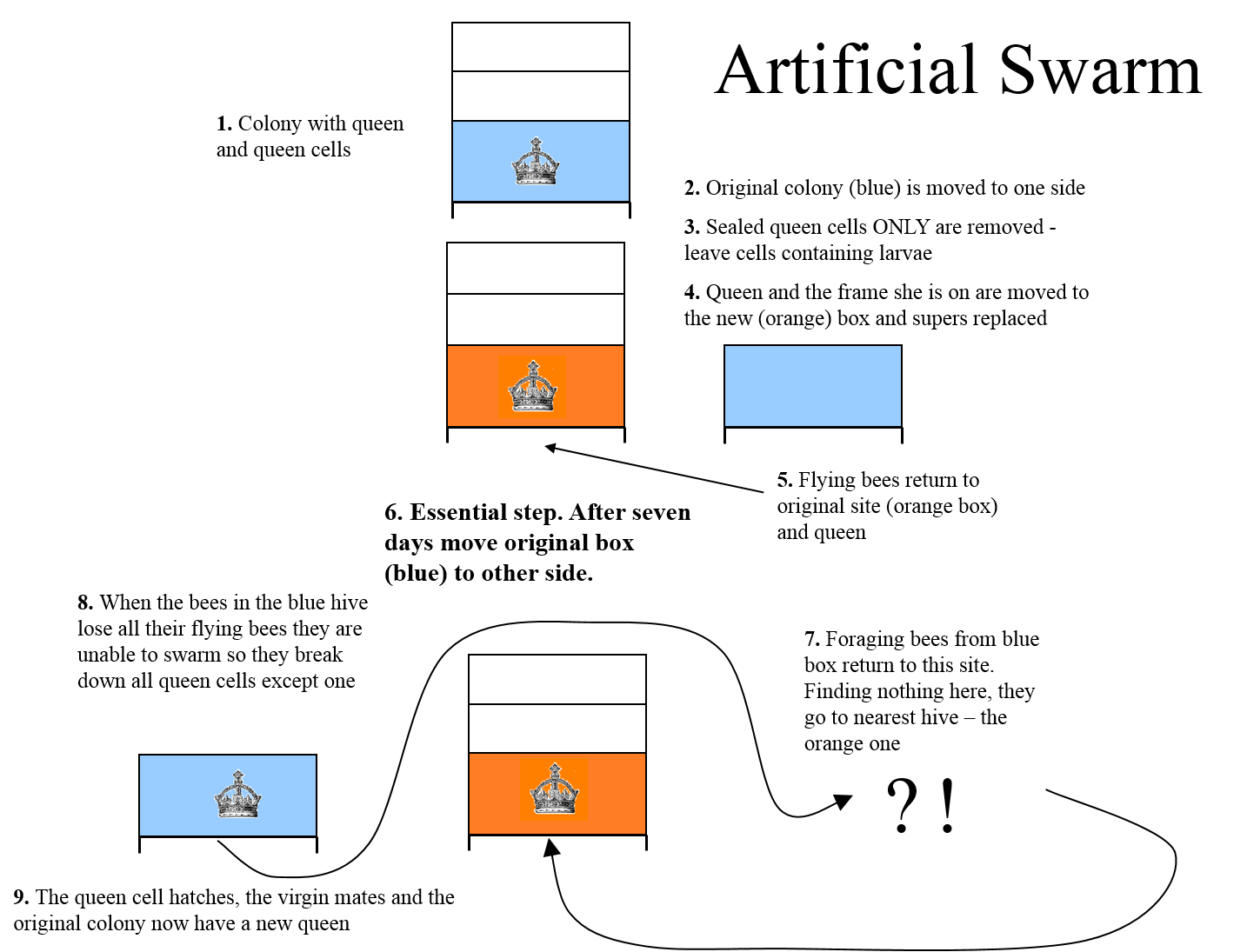The artificial swarm is the most common way of dealing with a hive which is preparing to swarm but for it to be successful, the bees need to be quite well advanced along that road.
Ideally (and this is important) your hive will have cells which are close to being capped. If not it would be best if possible to leave them for another few days. Detailed verbiage next or scroll to the bottom of the page for diagrammatic nutshell and links to multimeeja:
Equipment:
- A spare hive – floor, brood box, crown board and roof.
- A full complement of brood frames, preferably drawn or a mixture of drawn comb and some with new foundation.
- A rapid feeder
- Strong syrup.
Method:
- Set up a hive stand 18 inches to one side of your parent stand;
- Place the floor on it;
- Take the old brood box (Box A) containing all the bees, cells, queen etc and move it to the new stand;
- Set the new brood box (Box B) on the original, or ‘parent’ stand and remove two frames from the centre of the box;
- Find your queen and place her and the frame she is on – minus any and all queen cells in the space in Box B;
- Add the other frame;
- Go through Box A and remove any/all CAPPED CELLS ONLY BUT LEAVE THE REST ALONE;
- Add crown board and feeder with plenty of syrup whether or not you have given them foundation;
- Add roof and leave them alone for 7 days;
- All the flying bees from Box A will return to the queen in Box B who should now behave like a swarm and get on with their work;
- After 7 days you can either set up another stand 18 inches to the other side of the parent hive OR you can move them elsewhere within a couple of miles if that is more convenient – but no further away than that;
- Move the the entire hive containing Box A to that place;
- All the flying bees will leave Box A and join up with Box B and their old queen;
- Meanwhile Box A, finding themselves without flying bees will either take down all but one queen cell or they will allow the first emerged virgin to go round and do the job for them.
- If you have no faith in this, then interfere – but get it right. Select the best open cell at the start, when you take out the queen, and mark the place with a pin in the top bar of the frame then wait 7 days (when you move the box) before pruning the rest out.
- Either way they won’t swarm because they won’t have enough bees and eventually after another 3 weeks or so they will have a new queen laying.
- If you don’t want another hive of bees you can remove the old queen to a nuc and unite Boxes A and B over a sheet of newpaper.
But what about the supers says you? There is debate about this one. Hooper says to put them on Box B with the queen. However, supers contain a lot of young bees in which case the population will not be like a real swarm which contains just the older flying bees. So you might prefer to put the supers onto Box A until the old queen has settled to work again – about a week. Either way – feed where necessary.
Or here is the Artificial Swarm in a diagrammatic nutshell – click it for a bigger picture:
Or click here to download the singing-dancing animated Powerpoint slideshow. You will need to run this as a slide show Click the link below if you don’t know how to do this.
Click here if Powerpoint has you flummoxed
Click here for more on Swarm Prevention
Click here for some more Swarm Control methods
Click here for an easy way to hive that swarm if all this fails!
If you have a Snelgrove board, the artificial swarm can be done vertically doing away with the need for a spare floor and roof. Click here for photo’s and instructions on How to make your own Snelgrove board.
Copyright © Beespoke.info, 2014. All Rights Reserved.

This one is very interesting. May i know why we need to remove all capped queen cell in box A?
So that you can be sure that no virgin queen can emerge and lead a swarm before you come back in 7 days to move the hive to the other side.
If you left capped cells you don’t know when they were capped or when the virgins will emerge…
Thank you for the reply. so it means that they will swarm even if they are already queenless? Can i apply this method to apis cerana?
They might swarm. Once the urge is initiated, it doesn’t just go away. If they are strong enough and the weather is nice they might swarm and they might not. It’s a case of trying to cover all eventualities.
I work with Apis mellifera mellifera. I don’t know anything at all about Apis cerana.